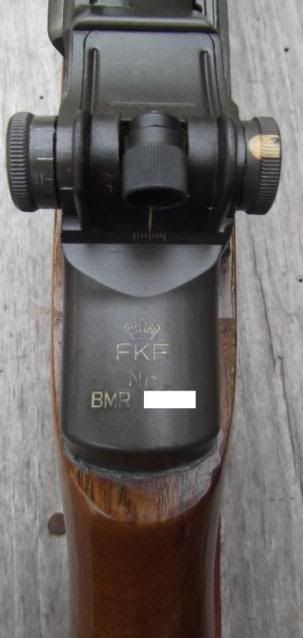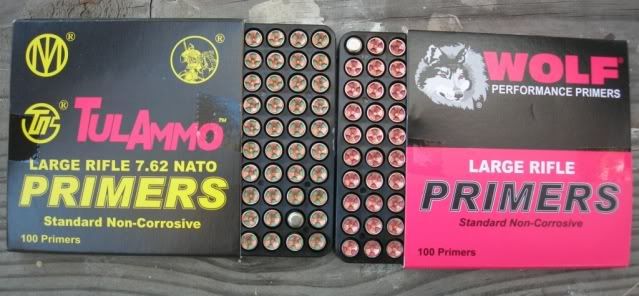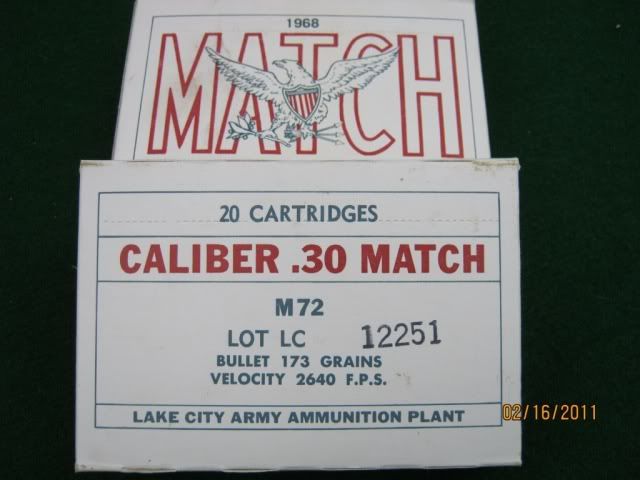
 |
|
|||||||
| Forum Rules | Firearms Safety | Firearms Photos | Links | Library | Lost Password | Email Changes |
| Register | FAQ | Calendar | Today's Posts | Search |
 |
|
|
Thread Tools | Search this Thread |
|
|
#1 |
|
Junior Member
Join Date: December 12, 2011
Posts: 4
|
How much do primers affect a load?
I'm new to reloading. I have read countless articles on this site and others about the process, what to look for, and have read the speer reloading manual and the abc's of reloading book. Using 150 grain sierra gameking sbt's with imr 4350, and using the sierra reloading manual no.5, i made about 30 rounds using winchester brass and the same OAL that is stated in the sierra book (2.780 i think), using anywhere between 40 and 44 grains of powder (max is 44.2). The only problem is i didn't notice that the loads in the sierra book were with federal 210M primers, and the primers i used are the standard federal 210's. How much will the primer difference affect these rounds? Are they even safe to shoot? I have searched online and through my reloading manuals and haven't found anything else on the 150 grain spb's. Any advice is greatly appreciated!
-Rob |
|
|
|
|
#2 |
|
Junior member
Join Date: May 16, 2009
Location: Central Texas
Posts: 1,343
|
They'll be fine! But just remember manuals are Only recommendations. You have to find out what your gun likes (brands, bullets, powder and how much) and also if different brands if primers makes a difference or not! You're doing great by reading, now it seems like to need to find out some things by experimenting and books can't tell you everything.
|
|
|
|
|
#3 |
|
Senior Member
Join Date: May 4, 2010
Posts: 5,468
|
Primers that don't work well for the powder, weight of charge, shape of chamber, etc, so forth, will not give consistent ignition, hence not consistent burning, hence wide swings in pressures, vibrations, velocities, and so forth.
In short, bad primers, or primers that don't work right can screw up a load as badly as any other component. A good bullet will shoot right with a good load. if you have a good bullet, a good rifle, a recommended powder, and you can't get good loads, switch primers for a trial, and see what happens. Unfortunately, there are quite a few variables to consider. any of a dozen things can, individually, can take what may have been a good load and turn it into something that could miss the barn wall. |
|
|
|
|
#4 |
|
Junior Member
Join Date: December 12, 2011
Posts: 4
|
Thank you for the replies! In the sierra manual it lists both the 150 grain sbt's and hpbt's as having the same data... is it safe to assume that both bullets create the same pressures, and if so can i safely use data from other manufacturers (namely hodgdon) for the hpbt bullet? (They do not list any data for the sbt's)
|
|
|
|
|
#5 |
|
Junior member
Join Date: May 16, 2009
Location: Central Texas
Posts: 1,343
|
Sure can , any repuable published load. Just remember those are just recommendations and with the test rifles that they tested with. You have a different gun and may act differently. Always start low and work up.
|
|
|
|
|
#6 |
|
Staff
Join Date: March 4, 2005
Location: Ohio
Posts: 21,743
|
The differences between the the 210M and the 210 are almost nil. The 210M is basically just a more carefully controlled 210. I've seen some side by side testing of the small versions, the 205 and 205M, and their difference appeared to be within normal lot-to-lot variance for either one and didn't merit a powder charge change. In the same test some magnum level primers were tried that did warrant reducing the powder charge by about 2%. In any event, since you are running a starting load 10% below maximum, that should cover even the use of a magnum primer as long as you start at the bottom and work up while watching for pressure signs.
__________________
Gunsite Orange Hat Family Member CMP Certified GSM Master Instructor NRA Certified Rifle Instructor NRA Benefactor Member and Golden Eagle |
|
|
|
|
#7 |
|
Junior member
Join Date: May 16, 2009
Location: Central Texas
Posts: 1,343
|
What was just said was "yes".
|
|
|
|
|
#8 |
|
Junior Member
Join Date: December 12, 2011
Posts: 4
|
Thank you farmerboy and unclenick, your willingness to share your expertise is greatly appreciated
|
|
|
|
|
#9 |
|
Senior Member
Join Date: May 27, 2007
Posts: 5,261
|
I recently ran a primer test. I had purchased Wolf and Tula7.62 primers. Tula 7.62 were advertized to be the same insensitivity as CCI #34’s, which are a mil spec primer. Mil spec primers are less sensitive than commercial primers, due to a combination of a thick cup, different primer mix, and some other factors. They exist because military weapons often have heavy free floating firing pins. Heavy free floating firing pins have a tendency to ignite sensitive primers before the trigger is pulled. An accidental discharge will range from embarrassing to fatal accident.
My load is a standard match load in the Garand. Garands are not magnums and the loads they fire are in today’s world, mild. Heavier loads, powders like IMR 4350, will over accelerate parts in the Garands leading to malfunctions and long term will damage parts. What I saw in my test, holding case, bullet, powder the same, was that velocities and group sizes change with change of primer. My old standby of the nickel plated WLR and CCI #34’s shot very well, the Wolf and Tula primers also shot very well. I was disappointed in the groups with Federal primers. Because of their sensitivity, I do not recommend Federal primers in Garands. Federals are the most sensitive primer on the market and the most slamfiring primer ever in Garands/M1a’s. So I can say, primers make a difference. But if I varied powder charge with each primer, those primers that gave disappointing groups the group sizes might have improved. Conducting a test like that would have taken lots of work, but I am confident to say, group sizes change with primer changes. So develop your load and when you get a good one, don’t change anything. I shot my load with Tula primers in a local 100 yard Highpower match and it shot very well in my NM Garand. The prone slow fire target is attached. Code:
Colombian Mauser Match 26” 1:10 Wilson barrel. 174 FMJBT White Box 1968 NM M72, Headstamp LC67 match, box velocity 2640 fps 14 Nov 2011 T = 68 °F Ave Vel = 2698 Std Dev = 51 ES = 117 High = 2771 Low = 2654 N = 5 174 FMJBT 47.0 IMR 4895 Lot L7889 thrown LC62NM CCI #34 OAL 3.30 14 Nov 2011 T = 74 °F Ave Vel = 2645 Std Dev = 12 ES = 42 High = 2671 Low = 2629 N = 10 Very good group 174 FMJBT 47.0 IMR 4895 Lot L7889 thrown LC62NM Tula 7.62 lot 1-10 primers OAL 3.30 14 Nov 2011 T = 74 °F Ave Vel = 2665 Std Dev = 9 ES = 28 High = 2677 Low = 2649 N = 10 Excellent Group 174 FMJBT 47.0 IMR 4895 Lot L7889 thrown LC62NM Wolf NCLR lot 18-09 OAL 3.30 14 Nov 2011 T = 74 °F Ave Vel = 2656 Std Dev = 15 ES = 36 High = 2677 Low = 2641 N = 9 174 FMJBT 47.0 IMR 4895 Lot L7889 thrown LC62NM Fed 210S OAL 3.30 14 Nov 2011 T = 74 °F Ave Vel = 2656 Std Dev = 13 ES = 34 High = 2674 Low = 2640 N = 10 174 FMJBT 47.0 IMR 4895 Lot L7889 thrown LC62NM WLR (Nickle) OAL 3.30 14 Nov 2011 T = 74 °F Ave Vel = 2665 Std Dev = 18 ES = 60 High = 2696 Low = 2636 N = 10 Excellent group 174 FMJBT 47.0 IMR 4895 Lot L7889 thrown LC62NM CCI200 OAL 3.30 14 Nov 2011 T = 74 °F Ave Vel = 2680 Std Dev = 14 ES = 56 High = 2712 Low = 2656 N = 10 V. Good group  Code:
M1 Garand BMR Receiver Douglas Barrel 1:10 twist 150 gr FMJBT 1966 Ball 14 Nov 2011 T= 74 ° F Ave Vel = 2545 Std Dev = 20 ES = 68 Low = 2513 High = 2581 N= 8 174 FMJBT White Box 1968 NM M72, Headstamp LC67 match, box velocity 2640 fps 14 Nov 2011 T = 74 °F Ave Vel = 2592 Std Dev = 28 ES = 103 High = 2647 Low = 2544 N = 10 174 FMJBT 47.0 IMR 4895 Lot L7889 thrown LC62NM CCI #34 OAL 3.30 14 Nov 2011 T = 74 °F Ave Vel = 2632 Std Dev = 20 ES = 60 High = 2671 Low = 2611 N = 10 174 FMJBT 47.0 IMR 4895 Lot L7889 thrown LC62NM Tula 7.62 lot 1-10 primers OAL 3.30 14 Nov 2011 T = 74 °F Ave Vel = 2582 Std Dev = 15 ES = 49 High = 2602 Low = 2553 N = 10 excellent group 174 FMJBT 47.0 IMR 4895 Lot L7889 thrown LC62NM Wolf NCLR lot 18-09 OAL 3.30 14 Nov 2011 T = 74 °F Ave Vel = 2607 Std Dev = 17 ES = 57 High = 2642 Low = 2585 N = 10 174 FMJBT 47.0 IMR 4895 Lot L7889 thrown LC62NM WLR (Nickle) OAL 3.30 14 Nov 2011 T = 74 °F Ave Vel = 2650 Std Dev = 19 ES = 68 High = 2688 Low = 2620 N = 10 Very good group 174 FMJBT 47.0 IMR 4895 Lot L7889 thrown LC62NM CCI200 OAL 3.30 14 Nov 2011 T = 74 °F Ave Vel = 2599 Std Dev = 22 ES = 75 High = 2637 Low = 2562 N = 10 Very good group   
__________________
If I'm not shooting, I'm reloading. Last edited by Slamfire; December 13, 2011 at 08:55 PM. |
|
|
|
|
#10 |
|
Senior Member
Join Date: March 1, 2009
Posts: 4,232
|
I read recently that primer problems can be one of the factors that causes vertical stringing. Can't remember where so I can't link to it
__________________
“How do I get to the next level?” Well, you get to the next level by being the first one on the range and the last one to leave.” – Jerry Miculek |
|
|
|
|
#11 |
|
Staff
Join Date: March 4, 2005
Location: Ohio
Posts: 21,743
|
Slamfire,
Thanks for posting all that data. It makes for an interesting read and validates some information I've collected. It also reminds me I have three Colombian Mausers I got from Springfield Sporters sometime in the early 90's, one of which is still just an action and a turndown bolt body that I have yet to put a barrel on. I should contour my unused 6.5 Douglas blank for it. Would you mind saying how many shots you fired for each velocity test? I'm interested in calculating the expected effect of random variation. Also, what distance was the middle of your chronograph from the muzzle? I assume you have the same information on NM ammunition I do (at the end of the post). I put the 1957-1966 (the IMR 4895 years as far as that data goes) in an Excel file and found it averaged 47.5 grains. However, if I adjusted the charges in fps/grain to all give 2640 fps, then the average of the adjusted loads came out at 47.0 grains. My interest in doing that was based on the assumption that even though the arsenals used bulk powder that wasn't blended to the controlled burn rate that canister grade IMR 4895 is today, their data would nonetheless average the same as the canister grade when you included data from enough different lots. It appears to be true at first blush. My Excel data is below. Code:
Year IMR 4895 Velocity Charge adjusted to get 2640 fps 1957 48.0 gr 2640 fps 48.0 gr 1958 48.0 gr 2640 fps 48.0 gr 1959 48.0 gr 2640 fps 48.0 gr 1960 48.0 gr 2640 fps 48.0 gr 1961 48.5 gr 2640 fps 48.5 gr 1962 48.1 gr 2685 fps 47.3 gr 1963 46.7 gr 2695 fps 45.7 gr 1964 46.0 gr 2669 fps 45.5 gr 1965 46.5 gr 2708 fps 45.3 gr 1966 47.2 gr 2711 fps 46.0 gr MEAN 47.5 gr 2667 fps 47.0 gr SD 0.8 gr 31 fps 1.2 gr ES 2.5 gr 71 fps 3.2 gr
__________________
Gunsite Orange Hat Family Member CMP Certified GSM Master Instructor NRA Certified Rifle Instructor NRA Benefactor Member and Golden Eagle |
|
|
|
|
#12 |
|
Senior Member
Join Date: June 25, 2009
Location: Stuttgart, AR
Posts: 1,569
|
Affects pistol also...
...which I saw two weeks ago when I was testing a series of 9mm rounds with the same bullets, brass, and series of powder charges, but different primers - CCI500 and Wolf.
The CCI rounds would cycle the slide at the lowest charge; whereas, the Wolf primered rounds stovepiped about 50 percent at the same charge. It was interesting to note the Wolf primer produced the tightest group, at 0.15” less than the CCI primer, but at a charge 0.2 grains higher. |
|
|
|
|
#13 |
|
Senior Member
Join Date: May 27, 2007
Posts: 5,261
|
“N” is the number of shots recorded. I fired ten rounds each target but the chronograph sometimes misses a few.
As for the primers being the same. If you only looked at the shipping box, you would conclude they are the same. Everything on the outside is the same, perhaps there are differences to the number codes stamped on the boxes. It was not until I opened the sheaves and looked at the primers that I saw any differences. The only visual difference between Tula 7.62 and Wolf primers is green sealant and red sealant. Graf's claims Tula 7.62 is equivalent to the CCI #34, but does not make that claim for standard Tula primers. http://www.grafs.com/catalog/tech-re...roductId/22288 I do not have equipment to measure primer sensitivity, it could be different.  The NM 1968 boxes were filled with 1967 head stamped ammunition. 
__________________
If I'm not shooting, I'm reloading. |
|
|
|
|
#14 |
|
Staff
Join Date: March 4, 2005
Location: Ohio
Posts: 21,743
|
Slamfire,
Thanks. I was groggy from too little sleep yesterday and it looks like my brain was in full gas passing mode, or I would have picked up on the N and the fact the Wolf was KVB7's (which TulAmmo also sells as their large rifle standard primer) and not KVB762's. Indeed, even though they import all the other KVB Boxer primers that TulAmmo sells, it doesn't look like the KVB762 is imported under the Wolf label at all. Like you, I don't have a sensitivity testing setup, so I can't say how different they actually are. There may be a difference in cup thickness or in inert material in the priming mix. Perhaps you can get a sense of that that just by weighing the primers? If the lacquer thickness looks any different, though, you might have to weigh fired ones that have been decapped to see if the metal portion is any different?
__________________
Gunsite Orange Hat Family Member CMP Certified GSM Master Instructor NRA Certified Rifle Instructor NRA Benefactor Member and Golden Eagle |
|
|
|
|
#15 |
|
Senior Member
Join Date: February 9, 2005
Location: Owego, NY
Posts: 2,000
|
Don't know why you guys haven't expanded your discussion a bit, I think the the OP is talking 30 cal. Cases with moderate to large powder charges are less susceptable to primer influence than smaller cases. FWIW - I see a notable difference in loads with different primers when loading my 221 Fireball. The small case capacity loads are a bit more temperamental.
__________________
,,, stupidity comes to some people very easily. 8/22/2017 my wife in a discussion about Liberals. Are you ready for civil war? |
|
|
|
|
#16 |
|
Staff
Join Date: March 4, 2005
Location: Ohio
Posts: 21,743
|
I think some of those small capacity cases suffer from the primer unseating the bullet ahead of the powder burn, making the start pressure erratic. The .22 Hornet is famous for doing that, so a really mild primer is needed for it.
In the big cases, a CCI employee had an article in Shooting Times once in which he remarked that in the same case you could find a standard primer did better if the case fill was high, but that if you had a lot of unused powder space, as is common with .30-06 loads for the Garand, that a magnum primer could reduce velocity spread because it pressurized the empty space more consistently. It always seems to come down to testing your load with your components in your gun.
__________________
Gunsite Orange Hat Family Member CMP Certified GSM Master Instructor NRA Certified Rifle Instructor NRA Benefactor Member and Golden Eagle |
|
|
 |
|
|